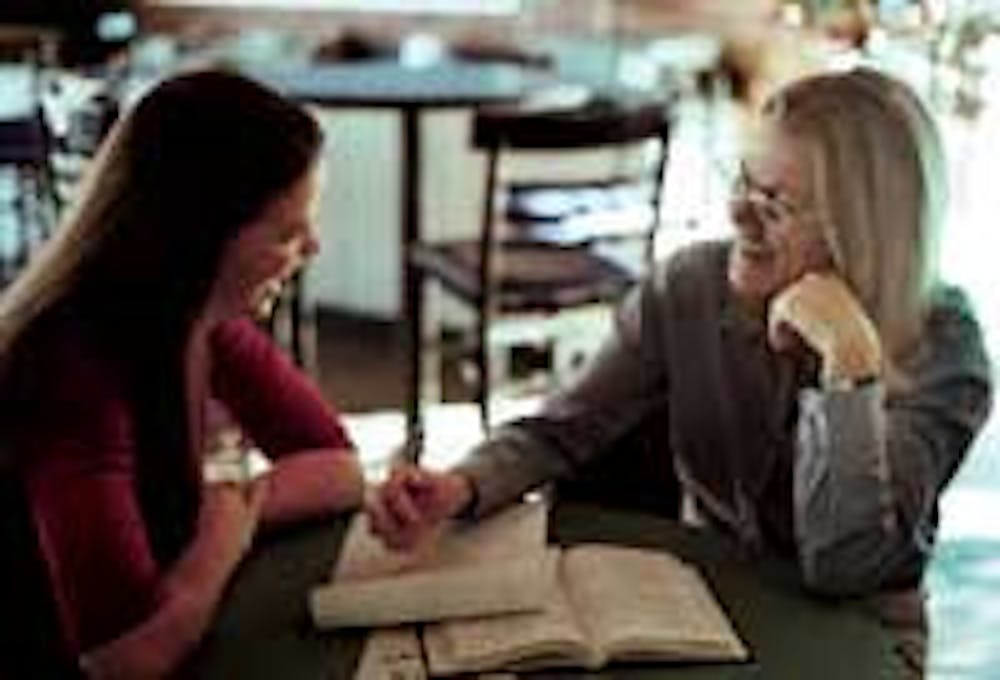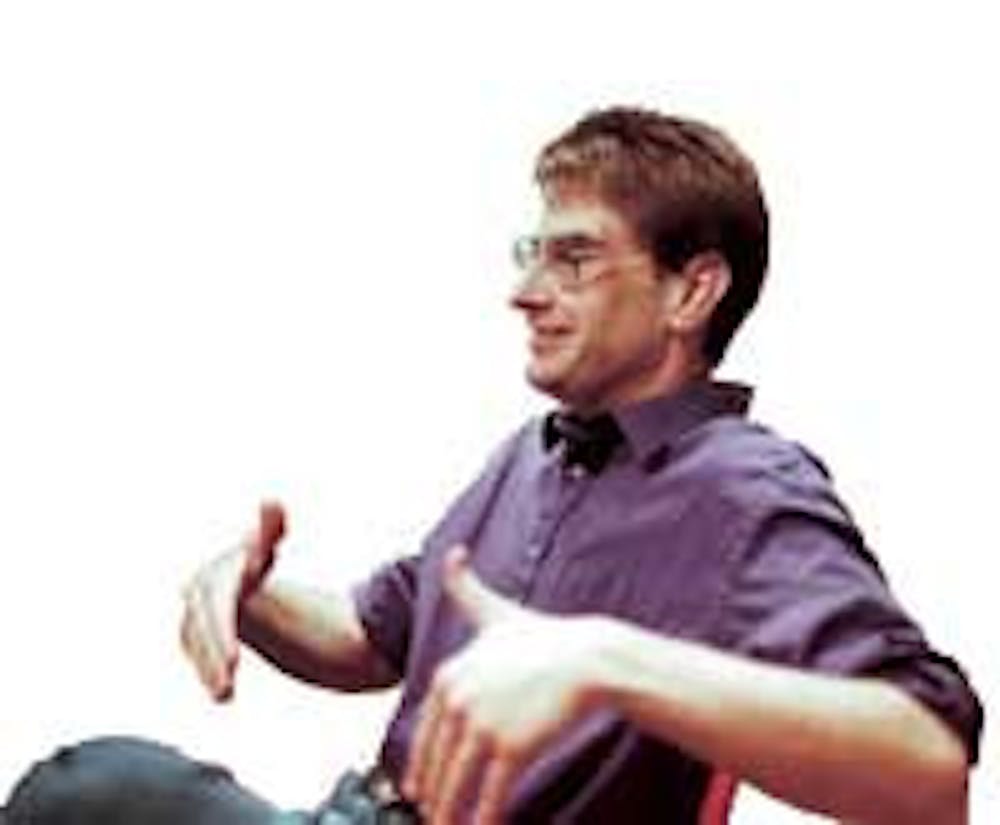ASU German teacher Shana Bell is vivacious, energetic and friendly. When she walks into a classroom on the first day of the semester, students often think she is a peer.
But it doesn't take long for them to take Bell, a teaching assistant supervisor, seriously.
Bell has booked many early morning, late night and meal time appointments for students in her four years teaching at ASU. She even invites some of them to her home.
"I come to ASU every day not so much because I love German," Bell said, "but because I love sharing German with my students. Some other instructors might just be here for the knowledge and research, but for me, teaching is very intimate and I get to know my students.
"That may not work for all teachers though," she said. "I can't imagine what it would be like trying to get to know everyone in a huge, huge lecture hall."
At a university with an 18:1 student to teacher ratio, many teachers at ASU do not actually hang out with students like Bell does. But for the professors, teaching assistants and faculty members who do, there are few relationships more valuable than those they form with students.
When students take one semester of German from Bell, she sees them grow dramatically as language students. When they take more than one semester from her, she sees them grow as people, she said.
"They change from high school students to adults," Bell added. "The connection I have with them gets me out of bed every morning."
It is this type of relationship that more teachers should strive for, said Ken Morrison, a religious studies professor who won the 2001 ASU Parent's Association Professor of the Year Award.
He attributes the honor to the dozens of hours he spends each week with students.
Morrison said few of his peers spend time with students outside of class and that ASU lacks in mentor relationships. He is working with other faculty members to get a campus teacher/student mentor program off the ground.
"It is so important to do everything you can to get to know a student and to help them develop as scholars and people," Morrison said.
He works about 80 hours a week and most of that time is working with students. He often invites them to his home for meals or gardening, and keeps open office hours.
"I know that this time is never wasted," he said. "Most students at ASU and other institutions have never had the opportunity to really speak with a faculty member, even though it's so important for a school that teachers and students have close relationships."
Not too close
Morrison is only friends with his students and said he is not aware of any ASU teachers who have sexual relationships with their students.
In case a relationship does turn sexual, however, ASU has guidelines for the parties involved to follow.
Sexual relationships are not prohibited, but favoritism and sexual harassment are.
The ASU sexual harassment policy that can be applied to teacher/student relationships states that, "Even an apparently consensual amorous relationship … may lead to sexual harassment or other breaches of professional obligations. … Due to the power difference, it may be difficult to avoid the appearance of favoritism or to assure a truly consensual relationship."
Morrison said he successfully avoids favoring the students with whom he is friendly.
"I've wondered if the students who don't come and visit me feel neglected, or jealous of the students who do spend time with me," he said. "But then I realize that I've made it clear that anyone can come and see me at any time. I know my students know that."
Bell is also careful to not play favorites.
"We have to really be consistent about not showing favoritism," she said. "And that can be difficult. You want your students to succeed and you could help them because you have the power over their grades.
"But no matter how close I am to a student, I can't grade them unfairly. That would damage my integrity and theirs," she added.
Both Bell and Morrison keep their office doors open to the public so everyone feels welcome.
Morrison also said it's important that students feel welcome in his home. He said he rarely thinks about whether it seems scandalous to invite a female student there.
"Someone (jokingly) told me I should see that movie 'Wonder Boys,' (about a professor who has irresponsible intimate relationships with students) because I spend so much time with the people I mentor," he said. "I saw it and thought, 'Who would ever have a relationship like that? Is that what things are like at East Coast schools?'"
But Morrison does not pay attention to negative teaching examples. He's had a positive role model who overrides any negative scenario, and from him, Morrison learned so much of what he knows.
It starts with one
In 1967 Morrison met one of the most important people in his life, an art professor. He is now deceased, but his art still hangs in Morrison's Engineering Building office. Each time he sees the two framed, loud, '60s-style prints above his desk, Morrison remembers how important a role model can be.
"I look at those, and I think of how much he did for me and how enthusiastic he was about teaching," Morrison said. "And I'm reminded that that's how I want to be. That's what I want to pass on.
"If there were more relationships like that, and like the ones I have with so many of my students, this entire University would be affected dramatically," he added.
Bell said she feels the same way about mentoring.
"It's about breaking down the barriers and this image that I am 20 feet above them," she said. "I tell my students that I am open to them and their lives. That gives them the comfort and the security that they can come and talk to me about anything having to do with academics, but also very personal matters."
Keeping it tame
Relationships between professors and students rarely blur past friendships, but in the land of teaching assistants, romances occasionally bloom.
Fine arts senior Sarah Braden knows all about it. She fell in love with her current boyfriend, Daniel Kariko, a graduate art student, when he was one of several TA's in her beginning photography class in the fall of 2000.
"I saw him on the first day and said to the girl next to me, 'Look at that boy with the curly hair!' Curly hair is my obsession. It was very exciting."
The next week, Braden's friend said that 'the curly-haired boy,' Kariko, was her TA. Braden said she wished she could have been in Kariko's class, but said it would have held her back from dating him.
"I couldn't ever date a teacher," Braden said. "It would be awkward. You should wait until they're not your teacher anymore."
Kariko agreed and made it a policy to not date his students.
"It's unethical to date a student," Kariko said. "I don't think I would be able to grade them objectively. There are rules we learn in orientation that say we won't get fired, but that if you have a relationship with a student, someone else needs to grade them.
"It just gets so complicated that you figure you should just wait until they're not in your class anymore."
A happy medium
Dating students can create huge problems and should be avoided, said Richard Lebed, an assistant physics professor. But he thinks spending social time with them is still important.
"It's extremely helpful to have interactions," he said, in reference to physics department picnics and personal outings. "Some of the time you spend talking about physics and academics, but then you have to take a break. That's why on Friday afternoons, grad students usually come by my office and we go to local hangouts and drink a beer."
Lebed said anything more intimate than a casual beer can open a huge can of worms.
"TA's and professors should never date current students," he said. "But they should spend time together. It's a lot better here at ASU than some other universities though. I know that if you go to the old established East Coast schools, the professors have their heads in the clouds and are completely separated from students."
Morrison agreed with Lebed that ASU has slightly more teacher/student relations than other schools, but still thinks it's enough.
"We should all think about what mentoring is," Morrison said. "And then figure out how to do it. A good way to start is to go to a teacher's office hours. A good way for a teacher to start is to invite the student out to lunch.
"Mentoring could change a lot of things for the better," he added.
That's what his mentor told him 34 years ago, and that's what he has told the students he has mentored every year since.
Reach the reporter at michelle.beaver@asu.edu.





